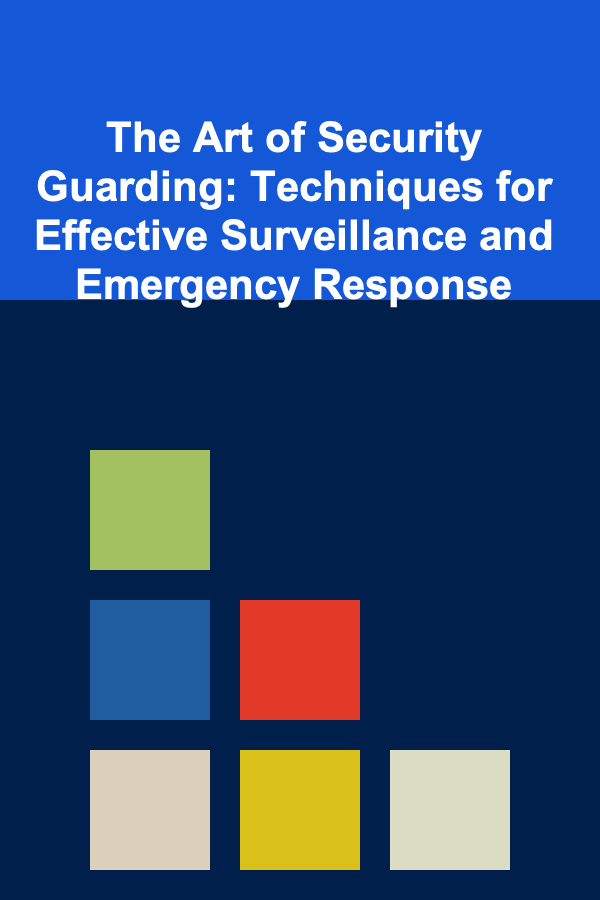
The Art of Security Guarding: Techniques for Effective Surveillance and Emergency Response
ebook include PDF & Audio bundle (Micro Guide)
$12.99$11.99
Limited Time Offer! Order within the next:

Security guarding is a dynamic and multifaceted discipline that requires vigilance, preparedness, and a range of specialized skills. Whether in a corporate environment, a public space, or a high-security facility, security guards play a vital role in maintaining order, preventing crime, and responding to emergencies. The effectiveness of security guards lies not only in their ability to monitor and patrol the premises but also in their ability to handle emergencies swiftly and competently. In this guide, we'll explore the techniques and practices necessary for effective surveillance and emergency response, providing actionable insights for those in the security profession.
The Role of a Security Guard
A security guard's primary role is to prevent unauthorized access, ensure safety, and deter criminal activity. However, their duties go beyond merely standing at the gate or patrolling the premises. Security guards are the eyes and ears of a facility, offering immediate responses to incidents and serving as a point of contact in case of an emergency. Their responsibilities can range from monitoring surveillance equipment to assisting in evacuations during fires or medical emergencies.
The modern security guard's work requires a combination of skills:
- Observation: The ability to detect unusual behavior or potential threats.
- Communication: Clear and effective interaction with both colleagues and the public.
- Crisis Management: Competence in dealing with emergencies or security breaches.
- Knowledge of Protocols: Understanding of security procedures and the legal aspects surrounding their duties.
Techniques for Effective Surveillance
Surveillance is one of the core responsibilities of security guards, and it involves the continuous monitoring of premises, both actively (through direct observation) and passively (through security systems like cameras and sensors). Effective surveillance requires sharp attention to detail, situational awareness, and an understanding of potential threats.
2.1 Situational Awareness
Situational awareness is the ability to understand what is happening around you, anticipate potential threats, and respond accordingly. It involves being alert to the environment, noticing details that others might overlook, and recognizing when something is amiss. Security guards should practice the following techniques to enhance their situational awareness:
- Scan the Area Regularly: Constantly check surroundings for suspicious activity or irregularities. This includes monitoring entrances, exits, and less visible spots such as back alleys or hidden corners.
- Maintain a Mental Map: Develop an understanding of the layout of the building or area you are responsible for. Knowing the locations of key assets, emergency exits, and high-risk areas allows guards to respond efficiently in case of an emergency.
- Be Aware of Behavior: Focus on behaviors rather than physical appearances. People acting unusually---such as loitering near restricted areas, pacing back and forth, or appearing overly nervous---can signal potential threats.
2.2 Surveillance Tools and Technology
Modern surveillance relies heavily on technology, which can dramatically enhance a guard's ability to monitor and assess potential threats. Some key tools include:
- CCTV Cameras: Closed-circuit television cameras are a common method of surveillance. Security guards should know how to monitor live feeds and review recordings, ensuring that the footage is clear and comprehensive. It's also crucial to know the locations of all cameras and ensure there are no blind spots.
- Motion Detectors: These sensors alert security personnel when movement is detected in restricted areas or at unusual times. Guards should be familiar with the sensitivity settings and calibrations of motion detectors to avoid false alarms.
- Drones: In larger facilities or open spaces, drones can provide aerial surveillance. These can help detect intruders or monitor wide areas, especially when CCTV coverage is limited.
- Alarms and Access Control Systems: Security systems that trigger alarms when unauthorized access is attempted can help in alerting guards immediately. Ensuring proper integration between surveillance systems and alarm mechanisms enhances response times.
2.3 Patrolling
Patrolling remains a critical aspect of surveillance. While cameras and sensors can monitor areas passively, human presence is often required to deter intruders and engage in real-time assessment of security situations.
- Regular and Random Patrols: Security guards should conduct regular patrols at consistent intervals but should also perform random checks to prevent predictability. Guards should cover all areas, including high-traffic zones and secluded locations.
- Engage with the Environment: While patrolling, security guards should interact with the environment, checking for tampering, damage, or anything out of the ordinary (e.g., doors left ajar or signs of forced entry).
- Documentation: After each patrol, guards should record their observations in a logbook. This includes noting times, any incidents, and areas covered. Documentation is vital for accountability and investigating security breaches.
2.4 Effective Communication
Communication is a key component of effective surveillance. A security guard should be proficient in both verbal and non-verbal communication. In addition, they need to be comfortable using radio systems, surveillance software, and incident-reporting platforms.
- Clear and Concise Reporting: Guards should be able to describe incidents or suspicious activity accurately and without delay. This includes using precise language to inform supervisors or law enforcement when necessary.
- Team Coordination: In larger operations, multiple guards may be working at different points on the property. It's important for guards to maintain open lines of communication, coordinate their activities, and report any findings to their team members promptly.
Techniques for Emergency Response
A security guard's ability to respond effectively to emergencies is perhaps the most critical aspect of their job. Whether it's a fire, medical emergency, or security breach, a well-trained guard can significantly mitigate the severity of the situation.
3.1 Crisis Management and Decision-Making
In emergencies, security guards must remain calm and make quick decisions. Effective crisis management includes the following:
- Stay Calm: In the heat of an emergency, maintaining composure is essential. Panic can cloud judgment and escalate the situation. Guards should follow procedures and trust their training.
- Follow Established Protocols: Most facilities have emergency response protocols for common situations (e.g., fire evacuation, active shooter). Guards should know these protocols inside and out to take appropriate action immediately.
- Prioritize Lives: In all situations, the safety and wellbeing of people come first. Guards should focus on evacuating individuals from danger zones, administering basic first aid if needed, and preventing the situation from worsening.
3.2 Fire Safety and Evacuation
In the event of a fire, a security guard plays a key role in ensuring the safety of occupants and minimizing damage to property. The following steps should be part of a guard's training in fire response:
- Evacuation Plans: Guards should be thoroughly familiar with building layouts, fire exits, and evacuation routes. During an emergency, they should guide people towards exits in a calm, efficient manner.
- Fire Safety Equipment: Guards should know the locations of fire extinguishers, alarms, and sprinklers. Depending on the situation, they may be required to use a fire extinguisher to contain small fires before the fire department arrives.
- Assisting Vulnerable Individuals: Guards must be able to assist elderly, disabled, or otherwise vulnerable individuals who may need help evacuating the building.
3.3 Medical Emergencies and First Aid
Security guards are often the first responders in medical emergencies, and basic first aid knowledge can save lives. Some key techniques include:
- Basic First Aid: Security guards should be trained in CPR, wound care, and basic trauma treatment. They should also know how to use an Automated External Defibrillator (AED) in case of a cardiac emergency.
- Contact Emergency Services: In serious medical emergencies, security guards should immediately contact emergency medical services. They should be able to provide accurate information about the incident, including the location and nature of the medical emergency.
- Calming the Individual: Guards should also be trained in basic psychological first aid, such as how to calm a person who is panicking due to an injury or medical distress.
3.4 Responding to Security Breaches
When responding to security breaches, guards should remain vigilant and take immediate steps to neutralize the threat while avoiding escalation. The following actions are typically required:
- Assess the Threat: Guards should quickly assess the nature of the breach, whether it's an unauthorized person on the premises, a potential intruder, or a terrorist threat.
- Contain the Situation: Depending on the threat level, security guards should take steps to contain the situation, such as locking down certain areas or guiding people to safe zones.
- Contact Authorities: If necessary, guards should contact law enforcement or other emergency responders to address the situation effectively. Clear communication about the threat's nature and location is crucial.
3.5 Dealing with Violent Incidents
Security guards may occasionally be required to deal with violent situations, such as physical altercations or threats of violence. It is crucial for guards to use de-escalation techniques first, as well as physical restraint, only when absolutely necessary.
- Verbal De-escalation: Guards should be trained to use calm, assertive language to de-escalate tense situations. This might involve setting boundaries and calmly asking individuals to leave the premises.
- Use of Force: In extreme cases, guards may need to use physical force to protect themselves or others. However, the use of force should always be proportional to the threat posed, and guards should be trained in appropriate restraint techniques.
Conclusion
Effective security guarding is a combination of preventative surveillance and rapid, decisive response in the face of emergencies. Whether dealing with a minor incident or a full-blown crisis, security guards must be prepared, trained, and equipped with the right tools to act swiftly and efficiently. By mastering techniques in surveillance, communication, crisis management, and emergency response, security personnel can provide crucial protection and ensure the safety of those under their watch.
The art of security guarding is not just about the ability to spot a threat---it's about responding with skill, confidence, and professionalism when the situation demands it.

How to Create a Sustainable Home Budget for Long-Term Savings
Read More
How to Design a Functional Laundry Room
Read More
How to Guide Small Businesses on Financial Compliance: An Actionable Guide
Read More
How to Market Your Accounting Services to Small Business Owners
Read More
How to Use Mirrors to Enhance Shoe Display Areas
Read More
How to Use Technology to Monitor and Reduce Noise Levels
Read MoreOther Products

How to Create a Sustainable Home Budget for Long-Term Savings
Read More
How to Design a Functional Laundry Room
Read More
How to Guide Small Businesses on Financial Compliance: An Actionable Guide
Read More
How to Market Your Accounting Services to Small Business Owners
Read More
How to Use Mirrors to Enhance Shoe Display Areas
Read More